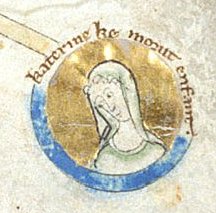by Susan Flantzer
© Unofficial Royalty 2022

An image of Katherine in a 14th-century illuminated manuscript; Credit – Wikipedia
Born on November 25, 1253, at the Palace of Westminster in Westminster, London, England, Katherine was the youngest of the five children and the third of the three daughters of Henry III, King of England and Eleanor of Provence. She was given the name Katherine because she was born on the feast day of Saint Katherine of Alexandria. Her paternal grandparents were King John of England and his second wife Isabella, Countess of Angoulême in her own right. Ramon Berenguer IV, Count of Provence and Beatrice of Savoy were Katherine’s maternal grandparents.

King Henry III (on top) with his five children; Credit – Wikipedia
Katherine had four elder siblings:
- King Edward I of England (1239 – 1307), married (1) Eleanor of Castile, had fourteen children (2) Margaret of France, had three children
- Margaret of England (1240 – 1275), married Alexander III, King of Scots, had three children
- Beatrice of England (1242 – 1275), married John II, Duke of Brittany, had six children
- Edmund Crouchback, 1st Earl of Lancaster (1245–1296), married (1) Aveline de Forz, no children (2) Blanche of Artois, had three children
On January 5, 1254, a large banquet was held to celebrate Katherine’s birth. Katherine was baptized by her mother’s maternal uncle Boniface of Savoy, Archbishop of Canterbury who was also her godfather. Within months of her birth, Katherine’s mother Eleanor of Provence had to leave England to join her husband King Henry III for a short while in the Duchy of Gascony, then a possession of the King of England, now in France. Katherine was left at Windsor Castle in the care of her governess Lady Emma le Despencer, the wife of Geoffrey le Despencer, Lord of Martley from one of the great noble families of England, and two wet nurses Agnes and Avisa. There was always a circle of trusted men and women to care for young Katherine when her parents could not be in her company.
The description by 13th-century chronicler Matthew Paris that Katherine was “‘mute and useless
though with a most beautiful face” has often been interpreted that she had an intellectual disability or degenerative disease. However, it may indicate that Katherine merely had a stammer or some other speech impediment. There is much disagreement on what disease or disability Katherine may have had, or if she had one at all. Contemporary evidence suggests that the reaction of Katherine’s parents to her illnesses followed a similar reaction to the illnesses of her siblings and that Katherine was treated no differently than her siblings, suggesting that there were no serious or long-term health concerns.
The South Ambulatory of Westminster Abbey, to the right of the main altar, where Katherine is buried
Katherine did have some kind of illness during the spring of 1257, that resulted in her death on May 3, 1257, when she was three and a half years old. Her parents King Henry III and Queen Eleanor deeply mourned her death and were emotionally distraught. Katherine was buried in the south ambulatory between the Chapel of Edward the Confessor and the Chapel of St. Benedict, to the right of the main altar at Westminster Abbey in London, England. In 1042, King Edward the Confessor began rebuilding St. Peter’s Abbey to provide himself with a royal burial church, the first Westminster Abbey. Construction of the second and present church began in 1245 by Katherine’s father King Henry III who selected the site for his burial.
This article is the intellectual property of Unofficial Royalty and is NOT TO BE COPIED, EDITED, OR POSTED IN ANY FORM ON ANOTHER WEBSITE under any circumstances. It is permissible to use a link that directs to Unofficial Royalty.
Works Cited
- Armstrong, Abigail Sophie, 2018. The Daughters of Henry III. Ph.D. dissertation. Canterbury Christ Church University.
- En.wikipedia.org. 2022. Katherine of England – Wikipedia. [online] Available at: <https://en.wikipedia.org/wiki/Katherine_of_England> [Accessed 30 August 2022].
- Fr.wikipedia.org. 2022. Catherine d’Angleterre — Wikipédia. [online] Available at: <https://fr.wikipedia.org/wiki/Catherine_d%27Angleterre> [Accessed 30 August 2022].
- Flantzer, Susan, 2015. King Henry III of England. [online] Unofficial Royalty. Available at: <https://www.unofficialroyalty.com/king-henry-iii-of-england/> [Accessed 30 August 2022].
- Williamson, David, 1996. Brewer’s British Royalty. London: Cassell.
